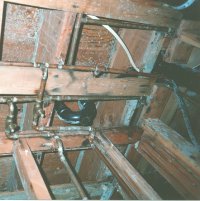Question: Is Aspergillus/Penicillium spore count in the basement high? We have this smell in our house for some time. We have also arranged for the gas company to come to see if there is gas leak. Last week, we had an air sample taken from our house. The Aspergillus/Penicillium reading from outside was 267 spores/m3 and the reading from the basement was 26,667 spores/m3. I do not know if these readings indicate any significance. Do you have any suggestions for the cause and solutions? Thank you very much for your help.
Answer: I think the Aspergillus/Penicillium spore count in the basement suggests persistent humid conditions. You may want to hire a professional to come and assess the extent of mold growth in the basement, identify the cause (i.e., moisture source) and suggest the best method to fix the moisture problem and remove the mold safely. To control the growth of mold such as Aspergillus/Penicillium the humidity in the basement has to be reduced to a level below 60%. The following techniques can help control moisture in the basement:
- Fix leaks, drips, and seepage problems.
- Dry wet areas within 24 to 48 hours to prevent mold growth. Thoroughly clean and dry water-damaged carpets and consider removal and replacement of items that appear to be permanently water damaged. Mold and mildew on hard surfaces can be washed and the surfaces dried completely.
- Do not finish a basement below ground level unless all water leaks are sealed. A finished basement should also have adequate outdoor ventilation and heat to prevent condensation.
- Operate a dehumidifier in the basement, if necessary, to keep relative humidity levels down. But keep in mind a dehumidifier can be expensive to operate.


 There are 2 groups of wood rot fungi. These are the wood-decaying fungi (wood-rotting fungi) and the Wood-staining fungi (sapstaining fungi).
There are 2 groups of wood rot fungi. These are the wood-decaying fungi (wood-rotting fungi) and the Wood-staining fungi (sapstaining fungi). Soft rot fungi such as Chaetomium globosum usually attack very wet wood, causing a gradual and shallow (3-4 mm) softening from the surface inward that resembles brown rot. The infested wood surface darkens and becomes very soft, hence the name soft rot.
Soft rot fungi such as Chaetomium globosum usually attack very wet wood, causing a gradual and shallow (3-4 mm) softening from the surface inward that resembles brown rot. The infested wood surface darkens and becomes very soft, hence the name soft rot.